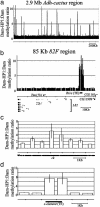Protein-DNA interaction mapping using genomic tiling path microarrays in Drosophila
- PMID: 12876199
- PMCID: PMC170935
- DOI: 10.1073/pnas.1533393100
Protein-DNA interaction mapping using genomic tiling path microarrays in Drosophila
Abstract
We demonstrate the use of a chromosomal walk (or "tiling path") printed as DNA microarrays for mapping protein-DNA interactions across large regions of contiguous genomic DNA in Drosophila melanogaster. Microarrays were constructed with genomic DNA fragments 430-920 bp in length, covering 2.9 million base pairs of the Adh-cactus region of chromosome 2 and 85,000 base pairs of the 82F region of chromosome 3. We performed DNA localization mapping for the heterochromatin protein HP1 and for the sequence-specific GAGA transcription factor, producing a comprehensive, high-resolution map of in vivo protein-DNA interactions throughout these regions of the Drosophila genome.
Figures



Similar articles
-
Chromatin profiling using targeted DNA adenine methyltransferase.Nat Genet. 2001 Mar;27(3):304-8. doi: 10.1038/85871. Nat Genet. 2001. PMID: 11242113
-
Mapping Drosophila genomic aberration breakpoints with comparative genome hybridization on microarrays.Methods Enzymol. 2006;410:377-86. doi: 10.1016/S0076-6879(06)10018-X. Methods Enzymol. 2006. PMID: 16938561 Review.
-
Genome-wide mapping of in vivo protein-DNA interactions.Science. 2007 Jun 8;316(5830):1497-502. doi: 10.1126/science.1141319. Epub 2007 May 31. Science. 2007. PMID: 17540862
-
Genome-wide HP1 binding in Drosophila: developmental plasticity and genomic targeting signals.Genome Res. 2005 Sep;15(9):1265-73. doi: 10.1101/gr.3198905. Epub 2005 Aug 18. Genome Res. 2005. PMID: 16109969 Free PMC article.
-
DamID: mapping of in vivo protein-genome interactions using tethered DNA adenine methyltransferase.Methods Enzymol. 2006;410:342-59. doi: 10.1016/S0076-6879(06)10016-6. Methods Enzymol. 2006. PMID: 16938559 Review.
Cited by
-
GeSICA: genome segmentation from intra-chromosomal associations.BMC Genomics. 2012 May 4;13:164. doi: 10.1186/1471-2164-13-164. BMC Genomics. 2012. PMID: 22559164 Free PMC article.
-
Hematopoietic transcriptional mechanisms: from locus-specific to genome-wide vantage points.Exp Hematol. 2014 Aug;42(8):618-29. doi: 10.1016/j.exphem.2014.05.004. Epub 2014 May 9. Exp Hematol. 2014. PMID: 24816274 Free PMC article. Review.
-
A sequence motif within chromatin entry sites directs MSL establishment on the Drosophila X chromosome.Cell. 2008 Aug 22;134(4):599-609. doi: 10.1016/j.cell.2008.06.033. Cell. 2008. PMID: 18724933 Free PMC article.
-
Defining transcriptional networks through integrative modeling of mRNA expression and transcription factor binding data.BMC Bioinformatics. 2004 Mar 18;5:31. doi: 10.1186/1471-2105-5-31. BMC Bioinformatics. 2004. PMID: 15113405 Free PMC article.
-
Positive selection drives the evolution of rhino, a member of the heterochromatin protein 1 family in Drosophila.PLoS Genet. 2005 Jul;1(1):96-108. doi: 10.1371/journal.pgen.0010009. Epub 2005 Jul 25. PLoS Genet. 2005. PMID: 16103923 Free PMC article.
References
-
- Reinke, V. & White, K. P. (2002) Annu. Rev. Genomics Hum. Genet. 3, 153–178. - PubMed
-
- White, K. P., Rifkin, S. A., Hurban, P. & Hogness, D. S. (1999) Science 286, 2179–2184. - PubMed
-
- Reinke, V., Smith, H. E., Nance, J., Wang, J., Van Doren, C., Begley, R., Jones, S. J., Davis, E. B., Scherer, S., Ward, S. & Kim, S. K. (2000) Mol. Cell 6, 605–616. - PubMed
-
- Hill, A. A., Hunter, C. P., Tsung, B. T., Tucker-Kellogg, G. & Brown, E. L. (2000) Science 290, 809–812. - PubMed
Publication types
MeSH terms
Substances
LinkOut - more resources
Full Text Sources
Molecular Biology Databases

